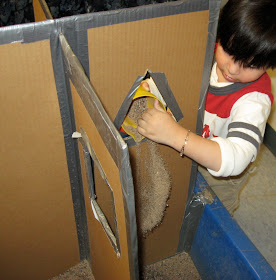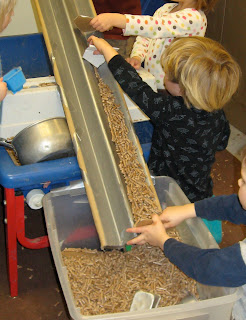Note that this is another version of the cardboard dividers(see previous post) in which the panels are low.
A hole is cut in two of the panels on one side. The cardboard tube is threaded through the holes and taped. A section of the tube in the middle has been cut away. Now besides the open spaces created by the vertical walls of the divider, the tube creates both horizontal and closed dimensions to the apparatus.
In another version of this combined apparatus, an additional plastic florescent light cover is embedded in the divider. This configuration is a little different because the table is used to support one end of the tube and channel and both the tube and channel extend over the end of the table so children can push the sand out of the tube and channel into the tub below.
Little construction vehicles are added because they fit nicely into the tube and channel and create a different type of play with moving the sand with front loaders and bulldozers.
If you look at dimensions to the right again, the cardboard divider is an open apparatus with vertical walls. The tube in the apparatus introduces a horizontal and closed dimension and the plastic channel adds an horizontal and open dimension.
What does that mean for play?
It offers opportunities for focused play in an individual space on a different level with a different dimension. The child below is playing with the truck and bulldozer on a level six inches above the bottom of the table. Now he can play on two levels in the same space. In addition, he is operating on a horizontal open plane. That naturally restricts his motor movements on that plane.
The child below is scooping sand with her hand from the tube. This is a horizontal plane that adds a closed dimension to the apparatus. How far can she move her hand when she scoops the sand? And how far into the tube can she reach to scoop the sand? She, too, can operate on two different physical levels. Actually, there is a third level with the tube when you see the tube as two separate levels: in the tube and on the tube. Both the channel and the tube offer motor experiences on a horizontal plane. The tube also offers motor experiences that are altered by the open/closed nature of the tube.
If also offers new challenges for transporting the sand both through the window and through the tube.
It also offers new opportunities for social interaction.
And it offers new opportunities for role play.
Children will explore all the spaces you give them. Their exploration lays the groundwork for knowledge of spatial relations. It almost sounds like math!






























